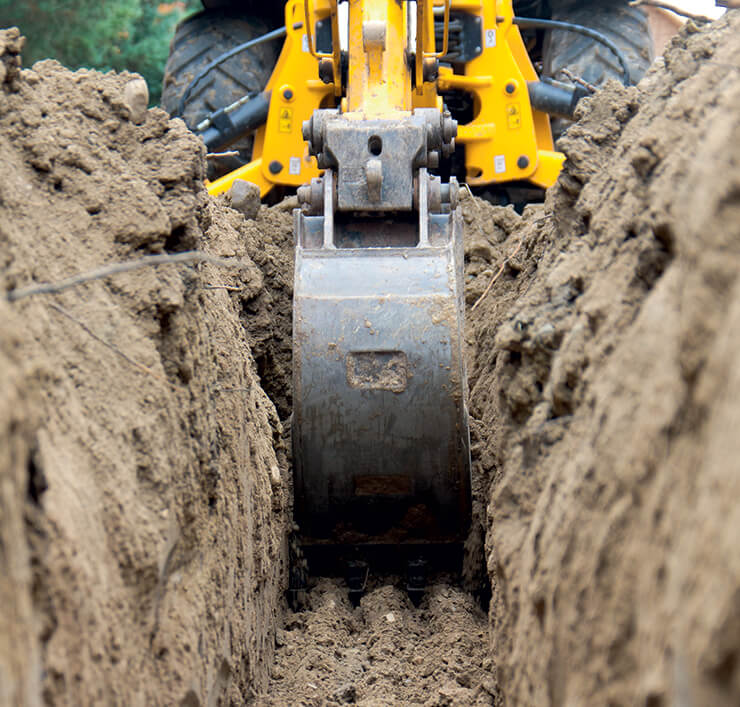
21st-22nd February 2026 - time to get your dream home started!
BOOK HERE
21st-22nd February 2026 - time to get your dream home started!
BOOK HEREWhile the construction industry may be regulated in terms of health and safety on site and for fundamental structural details, there are no minimum standards of training required for many of its workers.
Anyone can set themselves up in the ‘trowel occupations’ of groundworker or bricklayer and, as long as they are able to deliver the goods, no formal qualifications are necessary. As a result, many general builders have no official training behind them – but have instead learnt their skills through experience on-the-tools. So how can you choose the right people for the job?
The most common route into bricklaying in particular (but also groundworks to an extent) is via an apprenticeship. This usually takes at least a year and is typically divided between site work and some classroom training. There are two standard levels: NVQ2 or NVQ3.
With bricklaying these are designed to ensure the student becomes competent in brick bonding, mortar applications, wall ties, reinforcement, cavity trays, damp-proof courses (DPCs) and gains a little knowledge about ventilation and insulation, amongst other topics. Construction of chimneys, brick corbelling and arches are more advanced skills usually gained through experience under mentors on site.
A groundworks apprenticeship should focus on the installation of drainage and services, how to support open excavations safely, concrete work, basic reinforcement, the correct use of plant (heavy machinery) and so forth. Setting out – the process of establishing the precise location of trenches etc – is a particularly important part of the training.
All apprenticeship programmes should instruct the individual on how to interpret construction drawings, effectively communicate with other stakeholders on the site and – particularly relevant today – acquire minimum standards in both planning and practically applying health and safety.
Through their training, both groundworkers and bricklayers should be competent to operate within the parameters of the Building Regulations and Construction Design & Management Regulations (CDM) – according to the areas of their expertise.
Most regulatory focus is on health and safety on site, and you should expect them to establish and follow good practice, but it’s relatively rare for a safety inspector to visit a domestic job unless there has been a notifiable accident.
Similarly, a building control officer (BCO) can only ever make strategically timed inspections in order to look at certain site stages/conditions. These are pre-agreed, and the officer will attend when they have been notified (by you or the trade in question) that the work is ready to be checked.
With this in mind, your project will be realised using the skills of your contractors, possibly with some materials provided by you – or supplied and fitted by the relevant tradesperson. They’ll also interpret the drawings that you’ve procured and operate under the supervisory regime that you have put in place (for instance, you might manage the project yourself or you may choose to bring in a professional).
In terms of building control, you can either go through the local authority or use an approved inspector. With new builds, their work will be supplemented by the on-site inspection programme that accompanies the structural warranty you’ve chosen. The impact of this varies from provider to provider – some won’t make any visits, while others are quite proactive.

A small digger carving a trench. A variety of bucket sizes is available to make light work of excavations and ensure the resulting trench matches the application
By definition both groundworkers and bricklayers will do so, whether they think they do or not. This is because it’s rare that all of the requisite information will be on the drawings and specifications provided to them.
Typical examples where details might be lacking include DPC positioning, wall tie spacing, weep hole provision with cavity trays, external cill detailing etc. There might also be gaps in terms of how the drains run around the property and the exact location of inspection chambers and rodding eyes.
You’ll want to employ contractors who know their trade inside-out and who are able to contribute to the improvement of such details by providing helpful ideas. You’ll also want to be able to rely on them to meet the quality standards you expect as work proceeds and previous stages get covered up.
The groundworks team will be the first contractors on site and part of your critical path in the process: quite simply, all subsequent work has to wait until they’re finished.
Site clearance (removing unwanted vegetation) is usually reasonably straightforward – but demolition and substantial earth movement both require a more detailed approach to proceed safely and cost-effectively. Whilst your crew will do the setting out for foundations, they will usually expect some reference markers and/or profiles to enable them to do this. Typically your surveyor or architect would provide this.
If possible, try to get the drains, services, foundations and ground floor structure all completed at the same time. Having open trenches on a site can cause chaos, as it limits movement and constricts materials storage options.
In particular, make sure that any unwanted sub-base material is quickly removed from the site. But remember it’s often a good idea to retain your topsoil and store it sensibly out of the way, as this will prove a boon when you come to complete your landscaping.
Foundation depths are usually agreed with your building control officer. Nevertheless, a higher degree of skill is required where trenches get particularly deep and temporary shoring is needed. You should discuss this kind of situation with the groundworker before appointing them so you can gauge their level of confidence.
Finally, make sure your contract with them includes provision for temporary driveway and hardstanding areas. This should mean that, when they’re finished, the site is left organised, compacted, free of spoil and ready for the next set of trades to come in.
If you’re building with cavity walling, then the next crew on site will be the brickies – and once again they’re on the critical path. If you’re using a system such as timber frame, structural insulated panels (SIPs) or insulating concrete formwork (ICF) then this will be the next step, with the bricklayers (if you’re having this kind of cladding) following thereafter with various other trades.
Bricklayers normally operate in a three-man gang, which is considered the most efficient grouping, whereby a single labourer will service two competent brickies. The labourer will supply the mortar, bricks and blocks at the speed required by the crew. Their output will be measured by the amount of units that have been laid in a given session – but it’s weather dependent and will also be governed by the complexity of the work.
The simplest type of facing brickwork is single-skin stretcher bond featuring smooth-brushed mortar joints, with the outer finish tied back to the blockwork through an open cavity. Working at average speeds a gang might lay around 1,200 bricks per day (so 20m2 of facing work if we assume the standard 60 bricks per m2).
Thereafter pretty much everything conspires to slow the bricklayers down: window openings; beams and lintels; cavity trays; cavity insulation; changes in the bonding or brick pattern; ornate pointing; corbelled courses; and so the list goes on.
All of the above should be discussed in detail and agreed prior to appointing your gang, otherwise you’re likely to be disappointed with the quality or may end up facing charges for ‘extras’ you assumed would be included. In the worst-case scenario you might be forced to change your crew midway through the project – so ensuring they’re competent and having an established written spec is vital.
If planned properly in advance, with the assistance of a professional who understands the work, materials and labour can be quite easily split in a number of areas. Among the areas where you might consider supplying goods for your crews are:
Remember to make it absolutely clear what you’re going to be supplying and what goods you’re expecting your trades to provide. And be definitive about delivery times and who’s responsible for managing the items’ arrival, unloading, distribution on site and other elements.
| Headline rates for groundworks & bricklaying | |
|---|---|
| £450-£600 per day | Three-man bricklaying gang (costs highly sensitive and subject to complexity etc) |
| £25-£30 per m2 | Approximate per m2 rate for laying single-skin facing brickwork (detailing on top) |
| £400-£700 | Cost of good quality facing bricks per 1,000 units |
| £85-£95 per m3 | Cost of readymix concrete delivered in 6m3 loads (strengths vary) |
| £130 per day | Single day hire for an eight tonne excavator (delivery and fuel extra) |
| £60 per day | Single day hire for a two tonne excavator (delivery and fuel extra) |
| £600 per week | Seven day block-booked hire for an eight tonne excavator (fuel extra) |
| £220 per day | Rate for an excavator or dumper operator through a hire centre |
| £70 per week | Diesel-operated mixer (fuel extra) |
| £140-£200 per day | Skilled worker for day works (eg groundworks, bricklaying, roofing, general building tasks) |
| £120-£150 per day | Semi-skilled worker for day works (eg groundworks, bricklaying, roofing, general building tasks) |
| £200 | Eight cubic yard skip |
| £300+ | Grab lorry hire to clear skip |


Comments are closed.